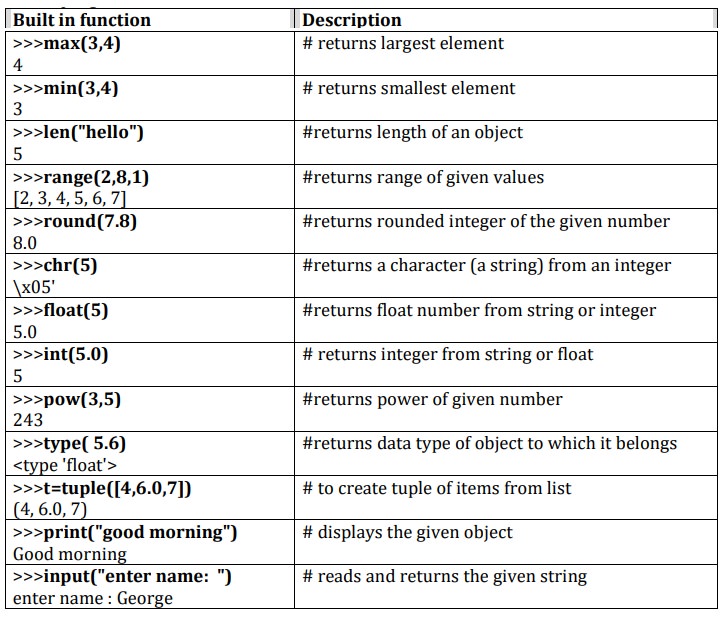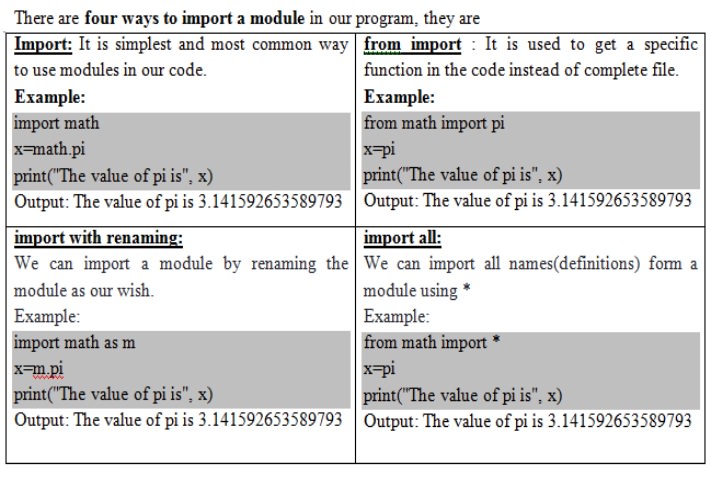Need, Types, definition, Syntax, Example - Functions - Python | Problem Solving and Python Programming : Data, Expressions, Statements
Chapter: Problem Solving and Python Programming : Data, Expressions, Statements
Functions - Python
FUNCTIONS:
Function is
a sub program which consists of set of instructions used to perform a specific
task. A large program is divided into basic building blocks called function.
Need For Function:
v When the program is too complex and large they
are divided into parts. Each part is separately coded and combined into single
program. Each subprogram is called as function.
v Debugging, Testing and maintenance becomes
easy when the program is divided into subprograms.
v Functions are used to avoid rewriting same
code again and again in a program.
v Function provides code re-usability
v The length of the program is reduced.
Types of function:
Functions can be
classified into two categories:
i)
user defined
function
ii)
Built in
function
i) Built in functions
v Built in functions are the functions that are already
created and stored in python.
These built in
functions are always available for usage and accessed by a programmer. It
cannot be modified.

ii)User Defined Functions:
v User defined functions are the functions that
programmers create for their requirement and use.
v These functions can then be combined to form module which
can be used in other programs by importing them.
v Advantages of user defined functions:
·
Programmers
working on large project can divide the workload by making different functions.
·
If repeated code
occurs in a program, function can be used to include those codes and execute
when needed by calling that function.
Function
definition: (Sub program)
v def keyword is used to define a function.
v Give the function name after def keyword
followed by parentheses in which arguments are given.
v End with colon (:)
v Inside the function add the program statements
to be executed
v End with or without return statement
Syntax:
def
fun_name(Parameter1,Parameter2…Parameter n):
statement1
statement2…
statement
n
return[expression]
Example:
def my_add(a,b):
c=a+b
return c
Function Calling: (Main Function)
Ø Once we have defined a function, we can call
it from another function, program or even the Python prompt.
Ø To call a function we simply type the function name with appropriate
arguments.
Example:
x=5
y=4
my_add(x,y)
Flow of
Execution:
v The order in which statements are executed is
called the flow
of execution
v Execution always begins at the first statement
of the program.
v Statements are executed one at a time, in
order, from top to bottom.
v Function definitions do not alter the flow of
execution of the program, but remember that statements inside the function are
not executed until the function is called.
v Function calls are like a bypass in the flow
of execution. Instead of going to the next statement, the flow jumps to the first
line of the called function, executes all the statements there, and then comes
back to pick up where it left off.
Note: When
you read a program, don’t read from top to bottom. Instead, follow the flow of execution. This means that you will
read the def statements as you are scanning from top to
bottom, but you should skip the statements of the function definition until you
reach a point where that function is called.
Function Prototypes:
i.
Function without
arguments and without return type
ii.
Function with
arguments and without return type
iii.
Function without
arguments and with return type
iv.
Function with
arguments and with return type
i) Function without arguments and without return type
o
In this type no
argument is passed through the function call and no output is return to main
function
o
The sub function
will read the input values perform the operation and print the result in the
same block
ii)
Function with arguments and without return
type
o
Arguments are
passed through the function call but output is not return to the main function
iii)
Function without arguments and with return
type
o
In this type no
argument is passed through the function call but output is return to the main
function.
iv) Function with arguments and with return type
In this type
arguments are passed through the function call and output is return to the main
function
Without Return
Type
Without argument
def add():
a=int(input("enter
a"))
b=int(input("enter
b"))
c=a+b
print(c)
add()
OUTPUT:
enter a 5
enter b 10
15
With argument
def add(a,b):
c=a+b
print(c)
a=int(input("enter
a"))
b=int(input("enter
b"))
add(a,b)
OUTPUT:
enter a 5
enter b 10
15
With return
type
Without argument
def add():
a=int(input("enter
a"))
b=int(input("enter
b"))
c=a+b
return c
c=add()
print(c)
OUTPUT:
enter a 5
enter b 10
15
With argument
def add(a,b):
c=a+b
return c
a=int(input("enter
a"))
b=int(input("enter
b"))
c=add(a,b)
print(c)
OUTPUT:
enter a 5
enter b 10
15
Parameters And Arguments:
Parameters:
·
Parameters
are the value(s) provided in the parenthesis when we write function header.
·
These are the
values required by function to work.
·
If there is more
than one value required, all of them will be listed in parameter list separated
by comma.
·
Example: def
my_add(a,b):
Arguments :
·
Arguments are
the value(s) provided in function call/invoke statement.
·
List of
arguments should be supplied in same way as parameters are listed.
·
Bounding of
parameters to arguments is done 1:1, and so there should be same number and
type of arguments as mentioned in parameter list.
·
Example:
my_add(x,y)
RETURN STATEMENT:
·
The return
statement is used to exit a function
and go back to the place from where it was called.
·
If the return
statement has no arguments, then it will not return any values. But exits from
function.
Syntax:
return[expression]
Example:
def my_add(a,b):
c=a+b
return c
x=5
y=4
print(my_add(x,y))
Output:
9
ARGUMENTS TYPES:
1. Required Arguments
2. Keyword Arguments
3. Default Arguments
4. Variable length Arguments
1. Required Arguments:
The number
of arguments in the function call should
match exactly with the function definition.
def
my_details( name, age ):
print("Name:
", name)
print("Age
", age)
return
my_details("george",56)
Output:
Name:
george
Age
56
2. Keyword Arguments:
Python
interpreter is able to use the keywords provided to match the values with
parameters even though if they are arranged in out of order.
def
my_details( name, age ):
print("Name:
", name)
print("Age
", age)
return
my_details(age=56,name="george")
Output:
Name:
george
Age
56
3. Default Arguments:
Assumes a
default value if a value is not provided in the function call for that
argument.
def
my_details( name, age=40 ):
print("Name:
", name)
print("Age
", age)
return
my_details(name="george")
Output:
Name:
george
Age
40
4. Variable length Arguments
If we want to
specify more arguments than specified while defining the function, variable
length arguments are used. It is denoted by * symbol before parameter.
def
my_details(*name ):
print(*name)
my_details("rajan","rahul","micheal",
ärjun")
Output:
rajan
rahul micheal ärjun
MODULES:
Ø A module is
a file containing Python definitions ,functions, statements and instructions.
Ø Standard library of Python is extended as modules.
Ø To use
these modules in a program, programmer needs to import the module.
Ø Once we import a module, we can reference or
use to any of its functions or variables in our code.
o There is large number of
standard modules also available in python.
o Standard modules can be
imported the same way as we import our user-defined modules.
o Every module contains many
function.
o To access one of the function , you have to
specify the name of the module and the name of the function separated by dot . This format
is called dot notation.
Syntax:
import
module_name
module_name.function_name(variable)
Importing Builtin Module:
import math
x=math.sqrt(25)
print(x)
Importing User Defined Module:
import cal
x=cal.add(5,4)
print(x)

Built-in python
modules are,
1.math – mathematical functions:
some of the
functions in math module is,
math.ceil(x) -
Return the ceiling of x, the smallest
integer greater than or equal to x
math.floor(x) -
Return the floor of x, the largest integer less than or equal to x.
math.factorial(x) -Return x factorial.
math.gcd(x,y)- Return the greatest common
divisor of the integers a and b
math.sqrt(x)- Return the square root of
x
math.log(x)- return the natural logarithm of
x math.log10(x) – returns the base-10
logarithms math.log2(x) - Return the
base-2 logarithm of x. math.sin(x) –
returns sin of x radians
math.cos(x)-
returns cosine of x radians
math.tan(x)-returns tangent of x radians
math.pi - The mathematical constant π =
3.141592 math.e – returns The
mathematical constant e = 2.718281
2. .random-Generate
pseudo-random numbers
random.randrange(stop)
random.randrange(start, stop[, step])
random.uniform(a, b)
-Return a random floating point number
Related Topics